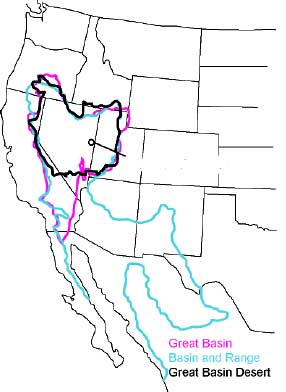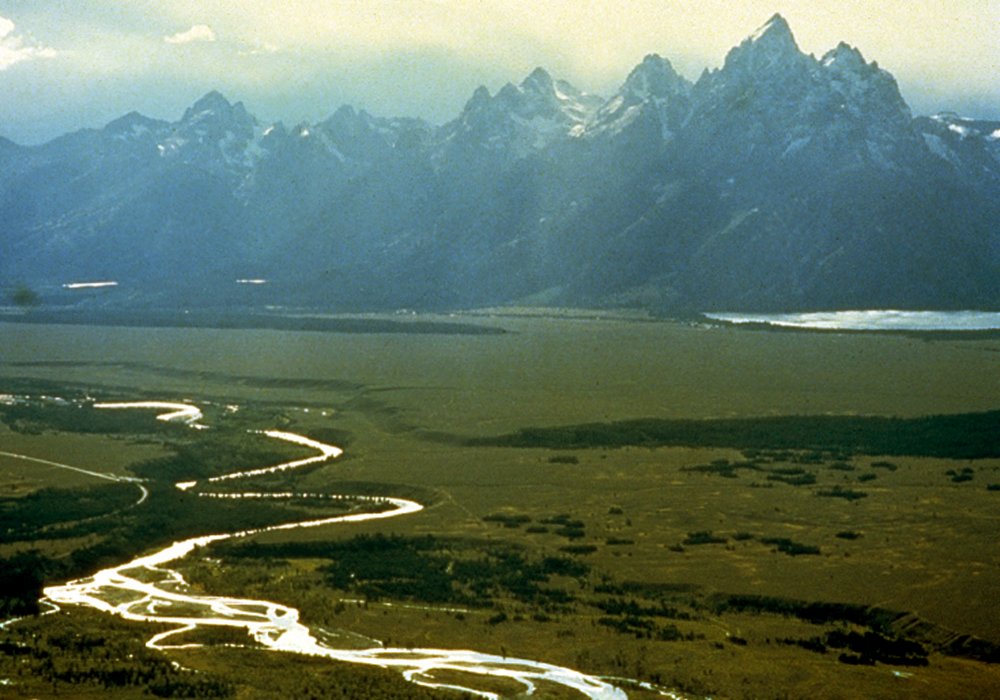|
Independence Mountains
The Independence Mountains are a mountain range in northern Elko County, Nevada, United States. They are called Settoya in Shoshoni. The range reaches a maximum elevation of on the summit of McAfee Peak. The range extends northward approximately from a point near Carlin to the banks of the Owyhee River. To the east is the North Fork of the Humboldt River, and to the west is the Owyhee Desert. Passing to the south is the main branch of the Humboldt River, and near the northern end of the range is the Wild Horse State Recreation Area. The Owyhee River is tributary to the Snake-Columbia system, while the Humboldt is within the Great Basin. From a point about seven miles north of Carlin, the range rises to Swales Mountain, at an elevation of . Dropping to an area of hills and buttes, it then rises again to Lone Mountain (Nannies Peak), at . The range then drops nearly to the level of the surrounding valleys, at a pass where State Route 226 connects to the community of Tus ... [...More Info...] [...Related Items...] OR: [Wikipedia] [Google] [Baidu] |
Mountain Range
A mountain range or hill range is a series of mountains or hills arranged in a line and connected by high ground. A mountain system or mountain belt is a group of mountain ranges with similarity in form, structure, and alignment that have arisen from the same cause, usually an orogeny. Mountain ranges are formed by a variety of geological processes, but most of the significant ones on Earth are the result of plate tectonics. Mountain ranges are also found on many planetary mass objects in the Solar System and are likely a feature of most terrestrial planets. Mountain ranges are usually segmented by Highland (geography), highlands or mountain passes and valleys. Individual mountains within the same mountain range do not necessarily have the same Structural geology, geologic structure or petrology. They may be a mix of different orogenic expressions and terranes, for example Thrust fault, thrust sheets, Fault-block mountain, uplifted blocks, Fold (geology), fold mountains, and vol ... [...More Info...] [...Related Items...] OR: [Wikipedia] [Google] [Baidu] |
Columbia River
The Columbia River ( Upper Chinook: ' or '; Sahaptin: ''Nch’i-Wàna'' or ''Nchi wana''; Sinixt dialect'' '') is the largest river in the Pacific Northwest region of North America. The river rises in the Rocky Mountains of British Columbia, Canada. It flows northwest and then south into the U.S. state of Washington, then turns west to form most of the border between Washington and the state of Oregon before emptying into the Pacific Ocean. The river is long, and its largest tributary is the Snake River. Its drainage basin is roughly the size of France and extends into seven US states and a Canadian province. The fourth-largest river in the United States by volume, the Columbia has the greatest flow of any North American river entering the Pacific. The Columbia has the 36th greatest discharge of any river in the world. The Columbia and its tributaries have been central to the region's culture and economy for thousands of years. They have been used for transportat ... [...More Info...] [...Related Items...] OR: [Wikipedia] [Google] [Baidu] |
Mountain Ranges Of Elko County, Nevada
A mountain is an elevated portion of the Earth's crust, generally with steep sides that show significant exposed bedrock. Although definitions vary, a mountain may differ from a plateau in having a limited summit area, and is usually higher than a hill, typically rising at least 300 metres (1,000 feet) above the surrounding land. A few mountains are isolated summits, but most occur in mountain ranges. Mountains are formed through tectonic forces, erosion, or volcanism, which act on time scales of up to tens of millions of years. Once mountain building ceases, mountains are slowly leveled through the action of weathering, through slumping and other forms of mass wasting, as well as through erosion by rivers and glaciers. High elevations on mountains produce colder climates than at sea level at similar latitude. These colder climates strongly affect the ecosystems of mountains: different elevations have different plants and animals. Because of the less hospitable terrain and ... [...More Info...] [...Related Items...] OR: [Wikipedia] [Google] [Baidu] |
Mountain City Ranger District
A mountain is an elevated portion of the Earth's crust, generally with steep sides that show significant exposed bedrock. Although definitions vary, a mountain may differ from a plateau in having a limited summit area, and is usually higher than a hill, typically rising at least 300 metres (1,000 feet) above the surrounding land. A few mountains are isolated summits, but most occur in mountain ranges. Mountains are formed through tectonic forces, erosion, or volcanism, which act on time scales of up to tens of millions of years. Once mountain building ceases, mountains are slowly leveled through the action of weathering, through slumping and other forms of mass wasting, as well as through erosion by rivers and glaciers. High elevations on mountains produce colder climates than at sea level at similar latitude. These colder climates strongly affect the ecosystems of mountains: different elevations have different plants and animals. Because of the less hospitable terrain and ... [...More Info...] [...Related Items...] OR: [Wikipedia] [Google] [Baidu] |
Tuscarora, Nevada
Tuscarora ( Shoshoni language: Tosa Konoki) is an unincorporated community in Elko County, Nevada, United States. The community lies on the east side of the Tuscarora Mountains approximately 40 miles north of Carlin. Tuscarora is part of the Elko Micropolitan Statistical Area. Far from being a ghost town, as several websites proclaim, Tuscarora is home to two schools, a library, a post office and a bar and grill, as well as homes for its very much alive residents. History Tuscarora was founded in Elko County after an expedition by trader William Heath to find gold, in 1867. The community derives its name from the Tuscarora people. As miners flocked to the town, a fort was built to offer protection from Indian raids and a water ditch was created to supply the town with water. Many Chinese men who had been employed by the Central Pacific Railroad (CPR) relocated to the town and began placer mining. By 1870, Tuscarora had a population of 119, of whom 104 were Chinese. A post ... [...More Info...] [...Related Items...] OR: [Wikipedia] [Google] [Baidu] |
Nevada State Route 226
State Route 226 (SR 226) is a state highway in Elko County, Nevada, United States. It spurs off State Route 225 north of Elko, and heads north for to Deep Creek. History 45px, left, SR 226 was part of the State Route 11 before 1976 SR 226 was part of a much-longer State Route 11 prior to 1976. Major intersections See also * * References {{Commons category 226 Year 226 ( CCXXVI) was a common year starting on Sunday (link will display the full calendar) of the Julian calendar. At the time, it was known as the Year of the Consulship of Severus and Marcellus (or, less frequently, year 979 ''Ab urbe co ... Transportation in Elko County, Nevada ... [...More Info...] [...Related Items...] OR: [Wikipedia] [Google] [Baidu] |
Lone Mountain (Independence Mountains)
Lone Mountain may refer to a place in the United States: * Lone Mountain, Tennessee, an unincorporated community * Lone Mountain (California), a hill in San Francisco, California ** Lone Mountain, San Francisco, California, the associated neighborhood * Lone Mountain (Montana), a mountain in the Madison Range * Lone Mountain, Nevada, a ghost town * Lone Mountain (Elko County, Nevada) * Lone Mountain (Eureka County, Nevada) * Lone Mountain (New York) Lone Mountain is a mountain located in Ulster County, New York. The mountain is part of the Catskill Mountains. Lone Mountain is flanked to the southwest by Table Mountain, and to the east by Rocky Mountain. The southeast side of Lone Mounta ..., a mountain in Ulster County * Lone Mountain State Forest, a mountain and state forest in Morgan County, Tennessee {{Disambiguation ... [...More Info...] [...Related Items...] OR: [Wikipedia] [Google] [Baidu] |
Great Basin
The Great Basin is the largest area of contiguous endorheic watersheds, those with no outlets, in North America. It spans nearly all of Nevada, much of Utah, and portions of California, Idaho, Oregon, Wyoming, and Baja California. It is noted for both its arid climate and the basin and range topography that varies from the North American low point at Badwater Basin in Death Valley to the highest point of the contiguous United States, less than away at the summit of Mount Whitney. The region spans several physiographic divisions, biomes, ecoregions, and deserts. Definition The term "Great Basin" is applied to hydrographic, biological, floristic, physiographic, topographic, and ethnographic geographic areas. The name was originally coined by John C. Frémont, who, based on information gleaned from Joseph R. Walker as well as his own travels, recognized the hydrographic nature of the landform as "having no connection to the ocean". The hydrographic definition is the ... [...More Info...] [...Related Items...] OR: [Wikipedia] [Google] [Baidu] |
Snake River
The Snake River is a major river of the greater Pacific Northwest region in the United States. At long, it is the largest tributary of the Columbia River, in turn, the largest North American river that empties into the Pacific Ocean. The Snake River rises in western Wyoming, then flows through the Snake River Plain of southern Idaho, the rugged Hells Canyon on the Oregon–Idaho border and the rolling Palouse Hills of Washington, emptying into the Columbia River at the Tri-Cities in the Columbia Basin of Eastern Washington. The Snake River drainage basin encompasses parts of six U.S. states (Idaho, Washington, Oregon, Utah, Nevada, and Wyoming) and is known for its varied geologic history. The Snake River Plain was created by a volcanic hotspot which now lies underneath the Snake River headwaters in Yellowstone National Park. Gigantic glacial-retreat flooding episodes during the previous Ice Age carved out canyons, cliffs, and waterfalls along the middle and lower Snake ... [...More Info...] [...Related Items...] OR: [Wikipedia] [Google] [Baidu] |




